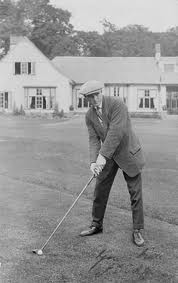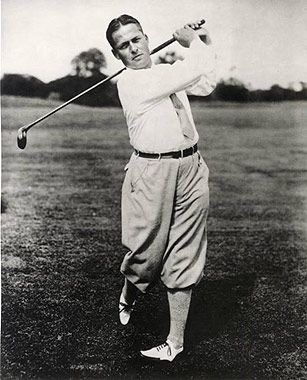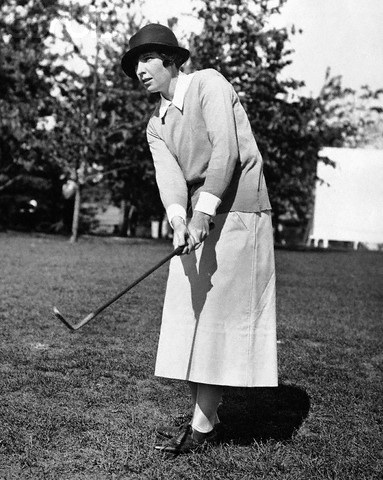Golf is truly a goddess and must be wooed accordingly, with due meekness and humility, but at the same time with boldness and determination. — J. Douglas Edgar
When you think of golf and Atlanta, the first name that pops into your head is Bobby Jones. His grave at Oakland Cemetery is visited by thousands each year. Some even leave golf balls in homage to the legendary sportsman.
But Jones is not the only golfing great to spend time in Atlanta. Englishman J. Douglas Edgar was his close friend and mentor. While you’ve probably never heard of him, his name was in the headlines next to Jones’ quite often. Edgar won the Canadian Open in 1919 by a record 16 strokes (a winning margin that still stands for a PGA Tour event), while Jones came in second. Edgar won it again in 1920.

J. Douglas Edgar’s new golf swing changed the world of golf forever. He discovered it by trial and error.
Unfortunately, the last time Edgar’s name would appear on the front page would be in a 1921 article about how he was discovered lying in a pool of his own blood in the middle of Atlanta’s West Peachtree Street.
J. Douglas Edgar was born in Newcastle upon Tyne in England in 1884. His family was not well off. At the age of 13, he found himself caddying to make money, although he had never played himself. One day a golfer invited him to give it a try and after swinging and missing it seven times, Edgar finally hit the ball. He was hooked on the game from that day on.

Steve Eubanks wrote about the life and death of J. Douglas Edgar in his book, To Win and Die in Dixie.
Edgar worked at various golf clubs over the next few years, his golf game mediocre at best. He had an ailing hip that limited his swing, something he tried to overcome with little success. His charm, however, won him many friends and golfing companions around the area.
Finally, with little in his pockets, he stumbled upon what came to be known as the Movement. While experimenting with various swings at High Gosforth Park Race Course, he decided to give his aching hip a break and not take full swings. Randomly, he decided to take an even more abbreviated swing, locking his upper arms against the muscles in his chest. He wanted to see how well he could hit it without turning his hip on the backswing.
When the ball clicked, Edgar knew at once that the shot was solid. Not only did the ball fly exactly as he had intended, it went farther than any shot he had hit in a year. Edgar had no idea that his discovery would become a cornerstone of golf instruction for the next century.

J. Edgar Douglas in 1915 (from left): Ted Ray, Edgar, fellow pro Ivo Whitten and British golf legend Harry Vardon.
As Edgar shared his new technique with his fellow golfers, he began to get noticed. He started participating in high-level tournaments and rubbing elbows with pro golfers like fellow Englishman Harry Vardon. World War I curtailed Edgar’s rise briefly. When it was over, golf was certainly not uppermost in the minds of its shellshocked survivors in Europe.
Despite having a wife and two children, Edgar decided to try his luck in America, leaving for New York City in March 1919. Thanks to the growing popularity of golf and the shortage of available pros to teach, Edgar quickly got a job at the Druid Hills Golf Club outside of Atlanta.
Shortly after arriving in Atlanta, Edgar teamed with Perry Adair (known as one of the “Dixie Whiz Kids”), in a foursomes match against Bobby Jones and Willie Ogg. The match went down to the wire with Jones and Ogg winning, one up, when Jones sank a putt on the final green. It was one of the few times Jones would beat Edgar that year or the year after.

Bobby Jones had a rather brief career but made an indelible mark. During a rough patch, he sought Edgar’s help and found renewed success.
The following matches between Jones and Edgar were private and plentiful. Years later, Jones said, “We played 36 holes together every Monday at East Lake. He was a marvelous teacher.” At a critical stage in his career, Jones turned to Edgar for advice and coaching. It helped jump start his stagnating performance.
Edgar’s wife, Meg, and their children eventually joined Edgar in Atlanta but it did not go well. Mrs. Edgar did not like the hot Atlanta summers or the incessant gossip she encountered as the wife of a successful golfer. Edgar was not home much, playing in tournaments around the country or working at Druid Hills. Among his many notable Atlanta pupils was Coca-Cola magnate Asa Candler.
Edgar also enjoyed the company of women and was known to love a good drink, despite Prohibition. Left with their children in their Atlanta cottage, it wasn’t long before Meg packed her trunks and took the children home to England, never to return. She would never see Edgar again.
Some say that one of Edgar’s love interests was Alexa Stirling. Despite her high-class pedigree, Stirling preferred hunting and fishing to attending balls. A childhood chum of Bobby Jones, she met Edgar in 1920 and began taking lessons from him at Druid Hills. Already one of the top-ranked amateur female golfers in the country, her game improved even more under his guidance.
Edgar’s fortunes continued to rise until a sweltering night in August would change everything. A passing car of reporters came upon Edgar’s bleeding body, on the verge of death. Because he was found lying in the street, most people assumed he’d been hit by a car. But his injuries indicated otherwise.
The only mark found on Edgar’s body was a deep wound near his groin, not from a bullet. He bled out, unable to hang on until medical help could arrive. Some theorized that a wound of that nature meant only one thing. A vengeful husband had punished Edgar for trifling with his wife.
While never proven, some believe Edgar was having an affair with the stunning young wife of prominent Japanese florist, William Abbey. Owner of the Nikko Inn, he’d already been tried and acquitted of shooting someone previously. Perhaps Abbey had taken out his anger on his wife’s lover.
The mystery of J. Douglas Edgar’s murder remains unsolved. A blossoming career was cut short in its prime. His name has since faded into obscurity. However, his book, The Gift of Golf, remains a classic for all golfers seeking to improve their performance.
Edgar is buried in Atlanta’s Westview Cemetery. A beautiful, mysterious Japanese woman was spotted visiting his grave soon after his death.
Edgar’s tombstone states the simple truth: “James Douglas Edgar, Native of England, One of the Great Golfers of the Age”.
And he was.



Interesting! Another Atlanta golfer was Dorothy Kirby, 1920-2000. I thought she was at Westview, but she’s not there.
My Grandmother’s maiden name was Jane Edgar born and died in Annan Scotland. I am trying to establish if Douglas Edgar is a distant relative. Annan is just inside the English-Scottish border. Who were Douglas’s parents?
R BRUCE MURRAY MASTER GOLF PROFESSIONAL CANADIAN PGA
RBMGOLFER@aol.com
His parents were John and Ann Edgar, they were from the Northumberland region. Douglas was born (the third of four children) in Newcastle and grew up there. Annan and Newcastle look to be about 125 miles apart. Does that help?
My thanks for your information. I have learned that he had a grandson Michael Newrick. Do you know of him or his family? You could contact me directly at RBMGOLFER@aol.com with any info.
RE DOUGLAS EDGAR OR A MICHAEL NEWICK OR A DOUGLAS EDGAR THE GRANDSON OF J DOUGLAS EDGAR A PGA PROFESSIONAL.LOOKING FOR ANY INFORMATION PARTICULARLY CONTACT INFO OF THE ABOVE. note my change of email-RBMGOLFER2@GMAIL.COM